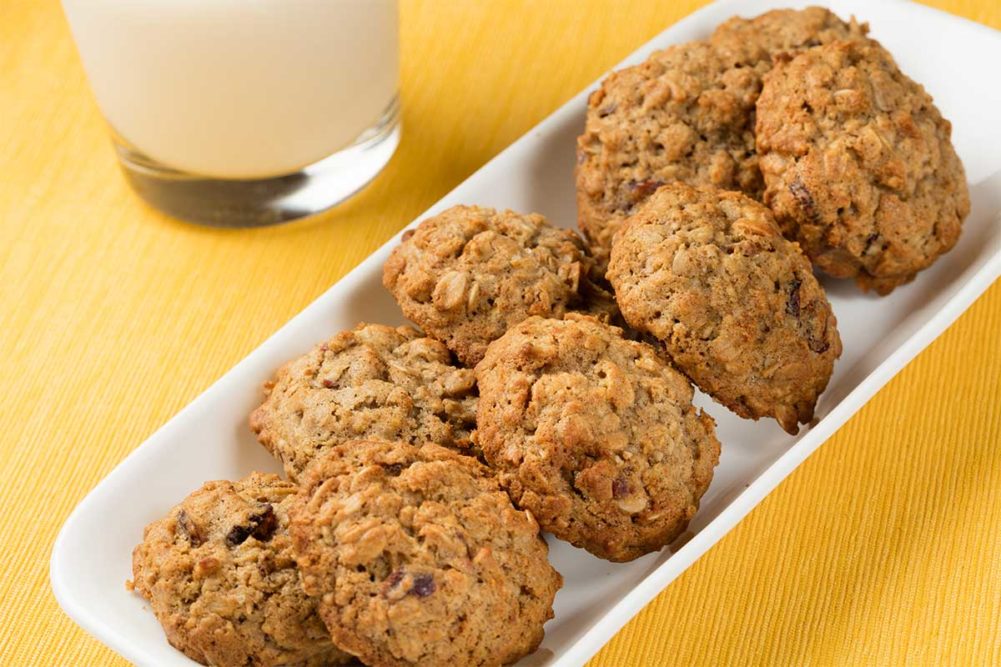Fibers function differently in formulations and in the body. Some bring unique attributes to baked goods.
CK Ingredients, for example, offers lupin bean products that contain 34% fiber along with 40% protein, with the ratio of insoluble to soluble fiber being 3:1. In addition to boosting nutritional value, lupin offers many functionalities.
“Lupin flour can extend the natural lusciousness of eggs and butter without the oiliness or eggy flavor,” said Colleen Madden, vice president of innovation, CK Ingredients. “Lupin flakes are rolled and are functionally similar to thick-cut rolled oats. They are golden in hue and chewy with a lot of visual appeal.”
Lupin possesses a unique flavor that adds complexity and depth to baked goods. It goes well with strong, rich brown flavors, such as chocolate, coffee and cinnamon.
“A simple sugar cookie is too two-dimensional for lupin, as it is simply sweet and buttery,” Ms. Madden said. “Chocolate chip cookies are the perfect application. The lupin offers a nutty, umami eating experience with crispy edges and a cakey middle. Further, the flavor complexity allows for as much as a 50% sugar reduction, allowing the chocolate chip flavor to pop.”
Because of the protein content, lupin contains more calories — about 3.5 per gram — than most other fiber ingredients. But that protein content helps make traditional carbohydrate-laden baked foods more appealing to high-protein dieters.
“Since lupin is synergistic with almond flour, for keto recipes, for example, it can offer a calorie reduction by replacing up to 50% of the almond flour,” Ms. Madden said. “Lupin is a ‘freak’ in the bean world since it is the only bean without starch. It helps you eat more fiber and protein and less starch and sugar.”
Chicory root fibers are well recognized for their ability to assist with sugar reduction, while adding fiber and reducing calories in baked goods. Some assist with fat reduction, too.
“Our natural, soluble and non-GMO chicory root fibers, inulin and oligofructose, can be easily incorporated to increase the fiber content in snack foods and baked goods,” said Kyle Krause, product manager for functional fiber and carbohydrates, BENEO. “Oligofructose can also be used in conjunction with high-intensity sweeteners to help mask undesired off-tastes.
[Related reading: The benefits of fiber]
“The fiber provides a neutral flavor, which enables smart sugar reduction while maintaining taste and texture of the final baked good,” Mr. Krause said. “Additionally, inulin can help to reduce the fat content of baked goods, particularly with long chain inulin, which has texturizing capability. Inulin can stabilize water into a creamy structure, mimicking fat, which is important for fillings.”
BENEO’s inulin and oligofructose are obtained from chicory root via a gentle hot water extraction. This harvesting from nature distinguishes it from certain other fibers that are made indigestible by chemical and enzymatic modifications.
All of the fiber within inulin and oligofructose is soluble and provides 2 calories per gram. Both powders and liquid ingredients are available to meet formulation and production requirements.
“Due to their solubility, products using these fibers avoid grainy mouthfeel,” Mr. Krause said. “They also act as a humectant, helping baked goods remain soft over time by binding water.”
Organic inulin agave is a soluble dietary fiber in Ingredion Inc.’s portfolio. Extracted from the agave plant, this fructan-type dietary fiber contributes 1.98 calories per gram and contains 93% dietary fiber with a touch of natural sweetness. The inulin travels to the large intestine where it is digested by beneficial bacteria. It has a low viscosity, even at levels as high as 15%.
This article is an excerpt from the September 2021 issue of Baking & Snack. To read the entire feature on Fiber, click here.





